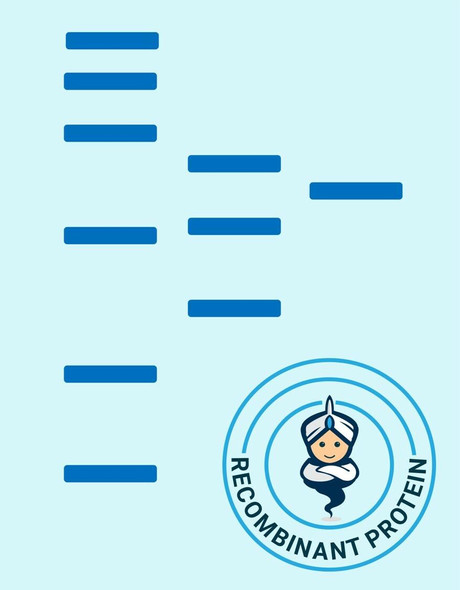Description
| Product Name: | Human CRYGC Recombinant Protein |
| Product Code: | RPPB3268 |
| Size: | 20µg |
| Species: | Human |
| Target: | CRYGC |
| Synonyms: | Crystallin, gamma C, Gamma-crystallin 2-1, Gamma-crystallin 3, CRYG3, CCL. |
| Source: | Escherichia Coli |
| Physical Appearance: | Sterile Filtered colorless solution. |
| Formulation: | The CRYGC solution (1mg/1ml) contains 20mM Tris-HCl buffer (pH 8.0), 200mM NaCl, 2mM DTT and 10% glycerol. |
| Stability: | Store at 4°C if entire vial will be used within 2-4 weeks. Store, frozen at -20°C for longer periods of time. For long term storage it is recommended to add a carrier protein (0.1% HSA or BSA).Avoid multiple freeze-thaw cycles. |
| Purity: | Greater than 95% as determined by SDS-PAGE. |
| Amino Acid Sequence: | MGSSHHHHHH SSGLVPRGSH MGSHMGKITF YEDRAFQGRS YETTTDCPNL QPYFSRCNSI RVESGCWMLY ERPNYQGQQY LLRRGEYPDY QQWMGLSDSI RSCCLIPQTV SHRLRLYERE DHKGLMMELS EDCPSIQDRF HLSEIRSLHV LEGCWVLYEL PNYRGRQYLL RPQEYRRCQD WGAMDAKAGS LRRVVDLY |
CRYGC is a member of the beta/gamma-crystallin family. Mammalian lens crystallins are distributed into alpha, beta, and gamma families; beta and gamma crystallins are also considered as a superfamily. Gamma-crystallins are a homogeneous group of extremely symmetrical, monomeric proteins usually missing connecting peptides and terminal extensions and are differentially regulated after early development. Three pseudogenes (gamma-E,F,G) and four gamma-crystallin genes (gamma-A,B,C,D) are structured in a genomic sector as a gene cluster. Gamma-crystallins are involved in cataract formation as a result of aging or mutations in specific genes. Mutations in CRYGC result in cataract Coppock-like (CCL) and cataract autosomal dominant (ADC).
CRYGC Human Recombinant produced in E. coli is a single polypeptide chain containing 198 amino acids (1-174) and having a molecular mass of 23.5kDa.CRYGC is fused to a 24 amino acid His-tag at N-terminus & purified by proprietary chromatographic techniques.
| UniProt Protein Function: | CRYGC: a major structural protein of the eye lens. A member of the beta/gamma-crystallin family. Gamma-crystallins are a homogeneous group of highly symmetrical, monomeric proteins typically lacking connecting peptides and terminal extensions. Gamma-crystallins are involved in cataract formation. |
| UniProt Protein Details: | Protein type:Cytoskeletal Chromosomal Location of Human Ortholog: 2q33.3 Cellular Component: cytoplasm; nucleus Molecular Function:protein binding; structural constituent of eye lens Biological Process: camera-type eye development; visual perception Disease: Cataract 2, Multiple Types |
| NCBI Summary: | This gene encodes a member of the beta/gamma-crystallin family of proteins. Crystallins constitute the major proteins of vertebrate eye lens and maintain the transparency and refractive index of the lens. This gene and several family members are present in a gene cluster on chromosome 2. Mutations in this gene have been shown to cause multiple types of cataract, including Coppock-like cataract and zonular pulverulent cataract, among others. [provided by RefSeq, Jan 2015] |
| UniProt Code: | P07315 |
| NCBI GenInfo Identifier: | 10518338 |
| NCBI Gene ID: | 1420 |
| NCBI Accession: | NP_066269 |
| UniProt Secondary Accession: | P07315,Q53R50, |
| UniProt Related Accession: | P07315 |
| Molecular Weight: | 23.5kDa (198aa), confirmed by MALDI-TOF |
| NCBI Full Name: | gamma-crystallin C |
| NCBI Synonym Full Names: | crystallin gamma C |
| NCBI Official Symbol: | CRYGC�� |
| NCBI Official Synonym Symbols: | CCL; CRYG3; CTRCT2�� |
| NCBI Protein Information: | gamma-crystallin C |
| UniProt Protein Name: | Gamma-crystallin C |
| UniProt Synonym Protein Names: | Gamma-C-crystallin; Gamma-crystallin 2-1; Gamma-crystallin 3 |
| Protein Family: | Gamma-crystallin |
| UniProt Gene Name: | CRYGC�� |
| UniProt Entry Name: | CRGC_HUMAN |






